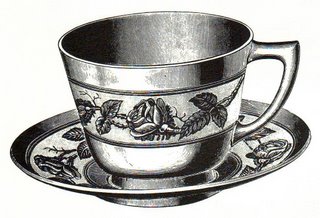 Today, October 27th …
Today, October 27th …Emily Post, the woman who was to become the authority on good manners, was born Emily Price on this day in 1872 in Baltimore. Her book “Etiquette in Society, in Business, in Politics and at Home” was published in 1922, and the rest, as they say, is etiquette history.
Her theory was quite simple: “Manners are a sensitive awareness of the feelings of others. If you have that awareness, you have good manners, no matter what fork you use”. The practice, however, was not. Luncheon, she says “is never so formidable as dinner”, even though it differs from that meal “in minor details only”. Some of the minor details in relation to luncheon are:
… fashionable ladies never take off their hats. Even the hostess herself almost invariably wears a hat at a formal luncheon in her own house …
The usual lunch hour is half past one. By a quarter to three the last guest is invariably gone.
The hostess, instead of receiving at the door, sits usually in the center of the room in some place that has an unobstructed approach from the door. Each guest coming into the room is preceded by the butler to within a short speaking distance of the hostess, where he announces the new arrival’s name, and then stands aside.
The gentlemen never offer their arms to ladies in going in to a luncheon.
The places are never left plateless, excepting after salad, when the table is cleared and crumbed for dessert.
… “corsage bouquets” laid at the places with flower pins complete are in very bad taste.
Emily also has something to say about the luncheon menu itself.
Five courses at most (not counting the passing of a dish of candy or after-dinner coffee as a course), or more usually four actual courses, are thought sufficient in the smartest houses.
She goes on to give more details as to the alternative menus:
Fruit, or soup in cups
Eggs
Meat and vegetables
Salad
Dessert
or
Fruit
Soup
Meat and vegetables
Salad
Dessert
or
Fruit
Soup
Eggs
Fowl or “tame” game with salad
Dessert.
And yet more details about the individual courses, (without, of course, giving actual recipes). She says about eggs at luncheon:
Eggs that are substantial and “rich,” such as eggs Benedict, or stuffed with pâté de foie gras and a mushroom sauce, should then be “balanced” by a simple meat, such as broiled chicken and salad, combining meat and salad courses in one. On the other hand, should you have a light egg course, like “eggs surprise,” you could have meat and vegetables, and plain salad; or an elaborate salad and no dessert. Or with fruit and soup, omit eggs, especially if there is to be an aspic with salad.
Recipe for the Day …
The aim of the rules and formulae of etiquette was to ensure every social event proceeded in calm and predictable fashion, and that no guest was embarrassed, upstaged, or unnerved. It appears that only the eggs were allowed to be a surprise. There are savoury and sweet versions of “Eggs Surprise”, although the placement of her comment suggests she meant the savoury version. Etiquette is all about certainty however, so I give you both versions, rather than risk making a gaffe.
EGGS EN SURPRISE.
Cut stale bread in two-inch slices and then in circular or elliptical shapes. Remove centres, leaving cases. Fry in deep fat until delicately browned and drain on brown paper. Half fill cases thus made with Creamed Asparagus tips. French poach six eggs, coat with egg (slightly beaten and diluted with one tablespoon cold water), roll in bread crumbs to which has been added Parmesan cheese (allowing two tablespoons cheese to three-fourths cup crumbs) and fry one minute in very hot, deep fate. Drain and arrange in croustades. Garnish with parsley.
(A New Book of Cookery; Fanny Farmer, 1912)
[Other versions of the era have the cooled poached eggs being battered and deep fried. TOF]
EGGS EN SURPRISE.
Take a dozen eggs, and make a small hole at each end of every egg, through which pass a straw and break the yolk; then blow out the yolk carefully. Wash the shells, and having drained, dry them in the open air; mix the yolk of an egg with a little flour to close one of the holes of the shells, and when dry, fill half the number by means of a small funnel, with chocolate cream, and the remaining six with coffee or orange-cream; close the other end of your eggs, and put them into a saucepan of hot water; set them on the fire, taking care they do not boil; when done, remove the cement from the ends; dry, and serve them on a folded napkin.
(The Cook's Own Book; Lee, N. K. M., Mrs. 1832)
Monday’s Story …
A Fish dinner on the Beach.
Quotation for the Day …
Etiquette is the science of living. It embraces everything. It is honour. Emily Post.
2 comments:
I went to a wedding in England and after we sat down at the table it was announced ladies could now remove their hats. There was some discussion at the table (we the only NZer's amongst the Brits) about when hats should be removed and surprisngly even the men at the table had an opinion on when it was appropriate.
Goodness! I had no idea these rules were still CURRENT! I'd better start taking Ms Post more seriously (although not for use here in OZ - we dont take ourselves quite that seriously).
Janet.
Post a Comment